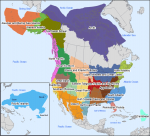
In November 2015 the National Academy of Sciences (NAS) released a report “An Evaluation of the Landscape Conservation Cooperatives”, which concluded that a landscape approach is needed to meet the nation’s conservation challenges and that the Landscape Conservation Cooperatives (LCCs) provide a framework for addressing that need. The NAS undertook the study pursuant to a Congressional directive to evaluate the LCC program.
For those not familiar with the LCCs, the initiative was launched by a Department of Interior Secretarial Order in 2009 specifically to enhance the landscape-level approach to conservation. The intent of the Secretarial Order was to design a cooperative effort to bridge jurisdictional boundaries across agencies within DOI as well as across other federal, state, and tribal agencies and private lands. The LCCs consists of 22 individual, self-directed conservation areas that cover all of the U.S. including islands, and parts of Canada, Mexico and Pacific Islands. A LCC Council composed of federal, state, local, tribal, and nongovernmental organizations manages the network and has adopted an overall strategic plan.

What were the highlights of the recent NAS evaluation? Most importantly the report identified the need for a landscape approach to resource conservation. The geographic scale and the complex web of management responsibility for natural and cultural resources demand a collaborative approach to conservation. And that this is especially true in a time of scarce resources. The committee concluded that given this national need to work at a landscape scale, Landscape Conservation Cooperatives were an appropriate way for the Department of Interior to address this need.
The NAS was also charged with examining other Federal programs with similar goals to assess overlaps and issues of coordination. The report concluded that the LCCs were uniquely positioned to address landscape conservation needs at a national scale, for all natural and cultural resources, in a way that bridges research and management efforts. For those interested in learning more about the range of Federal landscape programs, the report is valuable resource offering a catalog of 20 other federal agency landscape initiatives and providing an in depth analysis of four of them.
Finally, the report stated that after a little more than five years, it is too early to assess the outcomes of the program or to expect to see much in ways of improving the management and conservation of habitat and fish and wildlife species. The evaluation process needs to be improved such that the Network as a whole can measure and demonstrate how they have advanced the goals of the Network and its partners. However, it noted that the LCCs had achieved numerous objectives and milestones, especially related to developing collaborative governance and shared conservation goals.
The NAS concluded that the LCCs and the LCC Network have the necessary elements and structure to deliver on the national need for a landscape approach the individual LCCs can point to many early accomplishments, and have made progress toward the LCC Network’s high-level goals related to addressing conservation strategy, developing collaborative conservation, and advancing science for conservation.
The report is an important affirmation that resource conservation must be tackled on a landscape scale. Also of interest to on-the-ground practitioners are the case studies profiling the evaluation and outcomes of some longer running landscape scale initiatives (Chapter 6). These include National Heritage Areas, Pennsylvania Conservation Landscapes, Yellowstone to Yukon, and the Atlantic Coast Joint Venture. The report notes the important lessons to be learned from these programs that have been in existence for much longer period of time than the LCCs. These include such critical components as a unifying theme, strong stakeholder engagement, adaptive management, strategic planning efforts, metrics to aggregate project impacts, leveraging, and a lead agency that provides resources and/or leadership.
The National Academies of Sciences, Engineering, and Medicine are private, nonprofit institutions that provide independent, objective analysis and advice to the nation to solve complex problems and inform public policy decisions related to science, technology, and medicine. The Academies operate under an 1863 congressional charter to the National Academy of Sciences, signed by President Lincoln. For more information, visit www.nationalacademies.org.


